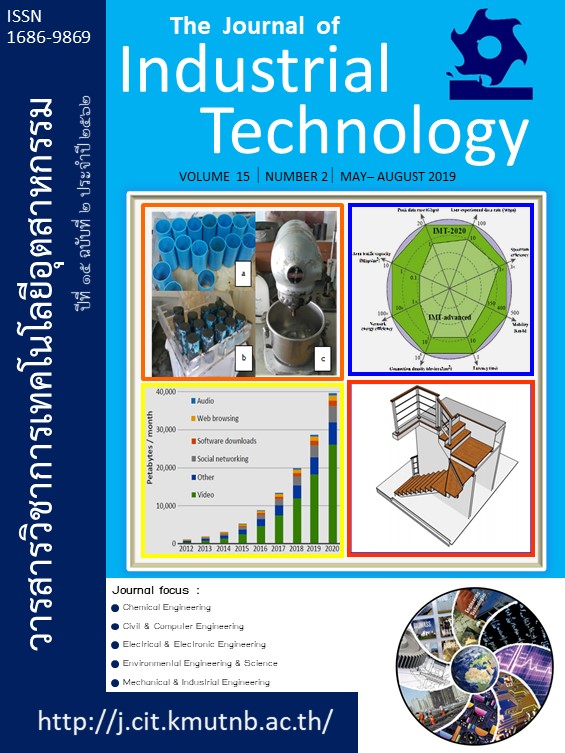การผลิตไบโอดีเซลจากน้ำมันพืชใช้แล้วโดยใช้ถังปฏิกรณ์แบบ ไฮโดรไดนามิกส์คาวิเตชั่น(Biodiesel Production From Waste Cooking Oil Using Hydrodynamic Cavitation Reactor)
Keywords:
Biodiesel, Waste cooking oil, Orifice plates, Hydrodynamics cavitation reactorAbstract
Abstract
The objective of this research was to study the optimum conditions for production of biodiesel by using hydrodynamic cavitation reactor through transesterification reaction with waste cooking oil and methanol, using potassium hydroxide as a catalyst. The effect of parameters on yield of biodiesel were focused. The parameters were studies, such as inlet pressure (2, 3 and 4 bar), methanol to oil molar ratio (4:1, 6:1 and 8:1), concentration of catalyst (0.5, 1 and 1.5 wt%) and reaction time (20, 30 and 40 minute) when reaction temperature (room temperature) was fixed at 28 °C. The experimental results showed that optimum conditions for biodiesel production from waste cooking oil were inlet pressure at 4 bar, methanol to oil molar ratio of 6:1, catalyst concentration of 1 wt% and reaction time at 30 minutes. Under the conditions, the obtained yield of biodiesel was 93%. In addition, the properties of the obtained biodiesel from optimum conditions were evaluated and it was found that the properties of biodiesel product was in the range of standard requirements of both biodiesel and low speed diesel fuel. In summary, hydrodynamics cavitation reactor can be applied to biodiesel production with one stage of transesterification reaction.
References
[2] M. Hawi, A. Elwardany, M. Ismail, and M. Ahmed, "Experimental Investigation on Performance of a Compression Ignition Engine Fueled with Waste Cooking Oil Biodiesel–Diesel Blend Enhanced with Iron-Doped Cerium Oxide Nanoparticles", Energies 12, 2019, p. 798.
[3] B. Tesfa, F. Gu, R. Mishra, and A. Ball, "Emission Characteristics of a CI Engine Running with a Range of Biodiesel Feedstocks", Energies 7, 2014, pp. 334-350.
[4] O. M. Ali, R. Mamat, N. R. Abdullah, and A. A. Abdullah, "Analysis of blended fuel properties and engine performance with palm biodiesel–diesel blended fuel", Renewable Energy 86, 2016, pp. 59-67.
[5] G. L. Maddikeri, P. R. Gogate, and A. B. Pandit, "Intensified synthesis of biodiesel using hydrodynamic cavitation reactors based on the interesterification of waste cooking oil", Fuel 137, 2014, pp. 285-292.
[6] A. Gholami, A. Hajinezhad, F. Pourfayaz, and M. H. Ahmadi, "The effect of hydrodynamic and ultrasonic cavitation on biodiesel production: An exergy analysis approach", Energy 160, 2018/10/01/ 2018, pp. 478-489.
[7] P. R. Gogate, "Cavitational reactors for process intensification of chemical processing applications: A critical review", Chemical Engineering and Processing: Process Intensification 47, 2008, pp. 515-527.
[8] L. F. Chuah, J. J. Klemeš, S. Yusup, A. Bokhari, and M. M. Akbar, "A review of cleaner intensification technologies in biodiesel production", Journal of Cleaner Production 146, 2017/03/10/ 2017, pp. 181-193.
[9] I. Worapun, K. Pianthong, and P. Thaiyasuit, "Optimization of biodiesel production from crude palm oil using ultrasonic irradiation assistance and response surface methodology", Journal of Chemical Technology & Biotechnology 87, 2012, pp. 189-197.
[10] P. R. Gogate and A. B. Pandit, "A review and assessment of hydrodynamic cavitation as a technology for the future", Ultrasonics Sonochemistry 12, 2005, pp. 21-27.
[11] L. Amin, P. Gogate, A. Burgess, and D. Bremner, Optimization of a hydrodynamic cavitation reactor using salicylic acid dosimetry vol. 156, 2010.
[12] L. F. Chuah, S. Yusup, A. R. Abd Aziz, A. Bokhari, and M. Z. Abdullah, "Cleaner production of methyl ester using waste cooking oil derived from palm olein using a hydrodynamic cavitation reactor", Journal of Cleaner Production 112, 2016/01/20/ 2016, pp. 4505-4514.
[13] I. Worapun, K. Pianthong, and P. Thaiyasuit, "Influence of orifice plates on percentage of methyl ester in synthesis biodiesel process under
hydrodynamic cavitation conditions ", SWU Engineering Journal 9(2), 2014, pp. 1-11. (in Thai)
[14] K. L. J. Ozonek, "Effect of different design features of the reactor on hydrodynamic cavitation process", Archives of Materials Science and Engineering 52, 2011, pp. 112-117.
[15] D. Ghayal, A. B. Pandit, and V. K. Rathod, "Optimization of biodiesel production in a hydrodynamic cavitation reactor using used frying oil", Ultrasonics Sonochemistry 20, 2013, pp. 322-328
[16] W. Roschat and J. Khunchalee, "Biodiesel Production Process from Crude Palm Oil using Calcium Oxide Derived from Cockle Shells as Economical and Green Catalyst", Journal of Science & Technology, Ubon Ratchathani University 20(1), 2018, pp. 94-106. (in Thai)
[17] P. Sangsri, “Biodiesel from the transmethylation of used cooking oil”, Master Thesis, Department of Chemical Engineering, Faculty of Engineering Prince of Songkla University, Thailand. 2010.
[18] ASTM, “Annual book of ASTM standards.” Vol. 05.01. Sec .5, Washington DC, 2001.
[19] Department of Energy Business, “Characteristic and Quality of Biodiesel Fuel (Methyl ester) Standard”, Available: http://www.ratchakitcha.soc.go.th/DATA/PDF/2556/E/158/15.PDFf, 05 January 2019. (in Thai)
[20] Department of Energy Business, “Characteristic and Quality of Diesel Fuel Standard”, Available: http://www.doeb.go.th/dtanotice/cancle-diesel25-01-56.pdf, 05 January 2019. (in Thai)


